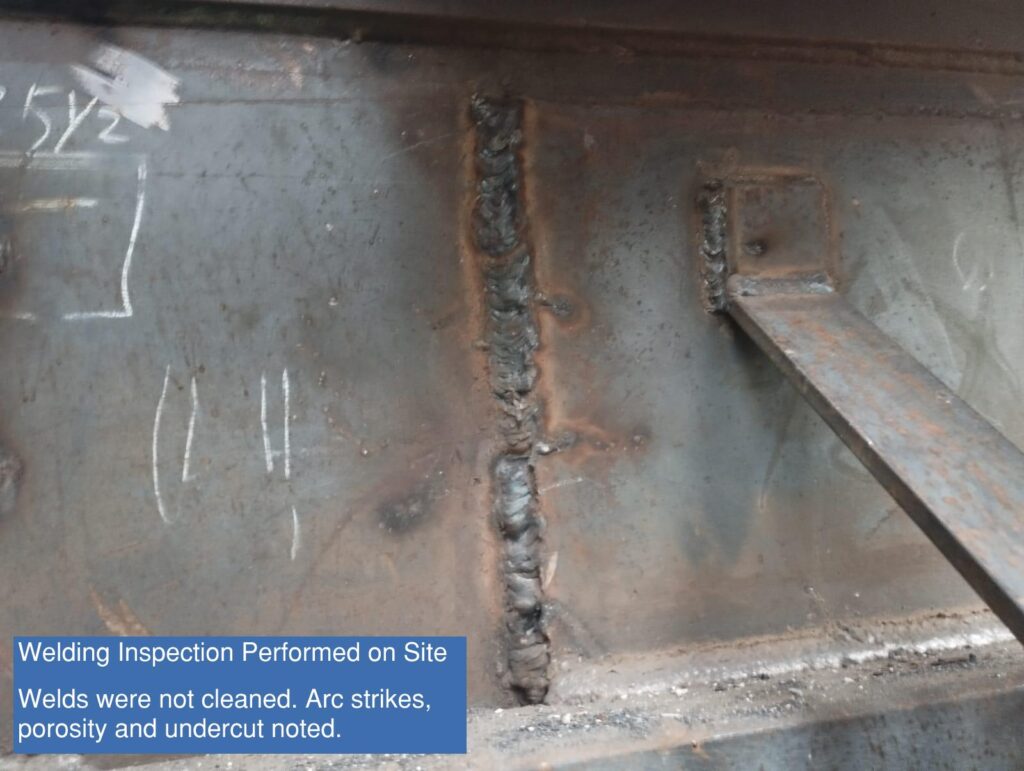Important Tips for Effective Welding Inspection Racine Services
Important Tips for Effective Welding Inspection Racine Services
Blog Article
Innovative Methods to Fillet Weld Examination and Screening: Enhancing Weld High Quality and Conformity Specifications
In the realm of welding, the high quality and stability of fillet welds play an essential function in guaranteeing the structural sturdiness and reliability of various industrial elements. With the continuous drive for enhanced performance and compliance with rigorous requirements, the exploration of cutting-edge methods to fillet weld assessment and screening has become critical. As sectors develop, the standard approaches may no more be enough in satisfying the needs of modern-day welding applications. By accepting advanced modern technologies and approaches, a new perspective of opportunities arises in the realm of weld quality assessment and adherence to conformity requirements.
Advanced Non-Destructive Screening Techniques
Utilizing modern innovations, progressed non-destructive screening methods play a vital role in making certain the stability and top quality of fillet welds. These techniques, such as phased array ultrasonic testing (PAUT) and magnetic fragment screening (MPT), deal in-depth understandings right into the weld's inner structure without creating any kind of damage to the material. PAUT, for instance, uses several ultrasonic aspects to check the weld from numerous angles, supplying an extensive visualization of prospective issues like lack of blend or cracks.
Similarly, MPT is effective in finding surface-breaking problems by applying a magnetic field and iron fragments to the weld location. This method is specifically valuable for determining suspensions that may jeopardize the weld's strength. By employing these advanced non-destructive screening techniques, weld examiners can properly analyze the top quality of fillet welds, guaranteeing conformity with industry requirements and laws. The ability to discover problems early not just improves weld quality but likewise stops costly rework or failures in structural honesty, highlighting the significance of these innovative screening approaches in welding inspections.
Robotics and Automation in Evaluation
The combination of robotics and automation has changed the inspection process for fillet welds, enhancing performance and accuracy in quality evaluation. Robotics use accurate control and repeatability in checking welds, ensuring reliable and regular outcomes. Automated systems can be configured to adhere to specific examination courses, making certain thorough insurance coverage of welds and decreasing the threat of human error.
Robotic evaluation systems furnished with innovative sensors can discover and measure weld attributes with high precision, giving detailed information for analysis. These systems can identify flaws such as fractures, lack of blend, and porosity, enabling punctual rehabilitative actions to be taken. Additionally, robotics and automation permit real-time data collection and analysis, offering instant comments to operators and facilitating fast decision-making procedures.
Moreover, the use of robotics and automation in fillet weld assessment boosts total productivity by lowering inspection times and enhancing assessment throughput. By simplifying the examination procedure, makers can ensure weld high quality and compliance standards are satisfied successfully, ultimately leading to set you back savings and improved product top quality.
Utilizing Artificial Intelligence for Evaluation
Synthetic intelligence plays a crucial duty in improving the performance and precision of analysis in fillet weld assessment processes. By utilizing the power of AI, inspectors can streamline the analysis of weld high quality and compliance standards, resulting in extra exact and trustworthy results. AI algorithms can quickly refine vast quantities of information from weld evaluations, detecting problems or inconsistencies that might be testing to understand the naked eye. This advanced innovation enables real-time tracking of weld top quality, permitting for instant rehabilitative actions to be taken if any kind of problems are identified.
Moreover, AI systems can pick up from previous inspection information, continuously boosting their capacity to identify prospective problems and inconsistencies in fillet welds. This adaptive knowing capability improves the total quality assurance procedure, reducing the likelihood of human mistake and making certain that welds meet the needed standards. By integrating expert system right into fillet weld evaluation, markets can achieve higher levels of effectiveness, consistency, and compliance in their inspection practices.
Portable Equipment for On-Site Assessment
 Enhancing area inspection efficiency, the fostering of mobile tools revolutionizes on-site analysis processes for fillet welds. These tools provide flexibility and benefit, enabling assessors to perform comprehensive assessments in different locations, including tough or remote atmospheres. Portable devices such as ultrasonic testing gadgets, magnetic bit examination equipment, and digital radiography systems provide real-time blog data and high-resolution imaging abilities, making it possible for quick decision-making and immediate responses on weld top quality.
Enhancing area inspection efficiency, the fostering of mobile tools revolutionizes on-site analysis processes for fillet welds. These tools provide flexibility and benefit, enabling assessors to perform comprehensive assessments in different locations, including tough or remote atmospheres. Portable devices such as ultrasonic testing gadgets, magnetic bit examination equipment, and digital radiography systems provide real-time blog data and high-resolution imaging abilities, making it possible for quick decision-making and immediate responses on weld top quality.One significant benefit of mobile devices is their capacity to simplify examination treatments, reducing downtime and boosting total productivity. Inspectors can easily deliver these devices to different work websites, removing the need for moving heavy machinery or components to off-site centers. In addition, the transportability of these tools promotes cost-effectiveness by minimizing transportation costs and increasing examination timelines.
In addition, the usage of portable tools for on-site assessment promotes aggressive quality assurance steps, as assessors can without delay identify and resolve any type of possible welding issues or disparities. By including these innovative technologies right into on-site examination techniques, welding professionals can make sure compliance with industry criteria and boost weld high quality, click this ultimately resulting in enhanced structural stability and security in different welding applications.
Assimilation of Data Management Systems
Having actually enhanced on-site examination procedures through the use of portable tools, the following stage involves the seamless integration of data administration systems to better improve performance and information evaluation capacities in fillet weld evaluation and screening. Welding Inspection Racine. By integrating data administration systems into the assessment process, companies can enhance data collection, storage space, and analysis. This combination enables for real-time surveillance of weld high quality, instant identification of problems, and prompt decision-making to remedy any concerns that may emerge throughout the inspection procedure
Data administration systems play an important function in systematizing inspection information, assisting in very easy accessibility for licensed workers, and ensuring data integrity and safety and security. Via the assimilation of these systems, inspectors can generate comprehensive records, track historical data for this content trend analysis, and boost total procedure effectiveness. In addition, the combination of data monitoring systems allows seamless communication in between different stakeholders associated with the inspection process, cultivating collaboration and enhancing total quality assurance actions. Ultimately, the integration of information monitoring systems serves to boost the criteria of fillet weld examination and screening, ensuring conformity with sector policies and improving weld top quality.
Final Thought
Finally, ingenious methods to fillet weld assessment and screening have actually significantly enhanced weld high quality and compliance criteria. Advanced non-destructive testing techniques, robotics, automation, fabricated intelligence, mobile devices, and data monitoring systems have reinvented the method weld assessments are carried out. By utilizing these innovations, industries can make sure that welds meet the required top quality criteria and regulations, eventually boosting general efficiency and safety in welding processes.

By using these innovative non-destructive testing techniques, weld inspectors can accurately examine the quality of fillet welds, ensuring compliance with industry standards and regulations. Portable tools such as ultrasonic screening devices, magnetic bit inspection tools, and digital radiography systems provide real-time data and high-resolution imaging capacities, enabling fast decision-making and prompt responses on weld high quality.
Having actually optimized on-site inspection processes with the application of portable devices, the following stage involves the seamless integration of data monitoring systems to additionally boost efficiency and information evaluation capabilities in fillet weld examination and screening (Welding Inspection Racine). Inevitably, the combination of data management systems serves to boost the requirements of fillet weld evaluation and screening, making certain compliance with market guidelines and improving weld high quality
 In final thought, innovative approaches to fillet weld examination and testing have actually dramatically improved weld top quality and compliance criteria.
In final thought, innovative approaches to fillet weld examination and testing have actually dramatically improved weld top quality and compliance criteria.Report this page